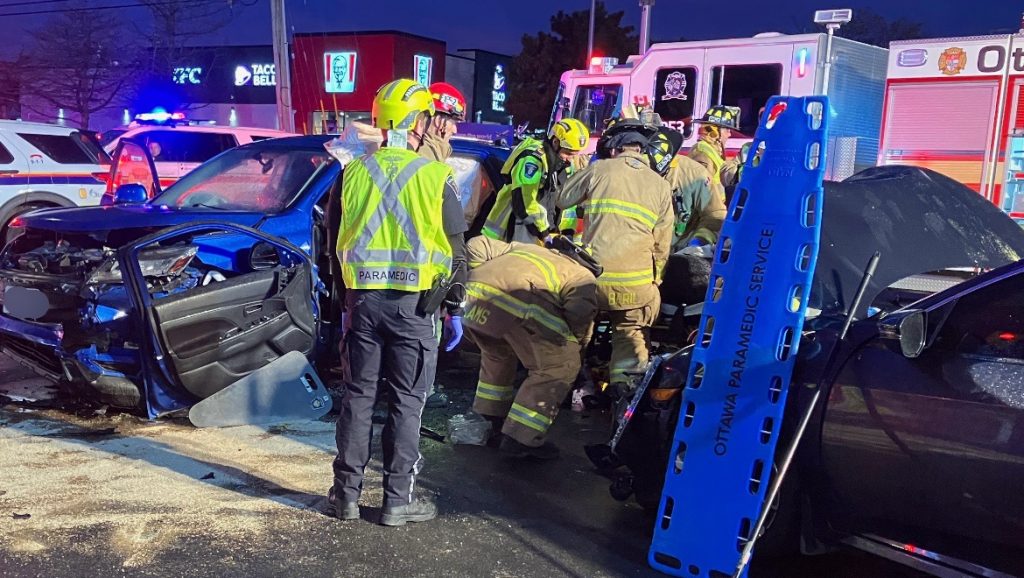Netflix series ‘Hemlock Grove’ tackles vamps, werewolves post-‘Twilight’
Posted Apr 16, 2013 04:31:19 PM.
This article is more than 5 years old.
TORONTO – There are certain expectations when horror master Eli Roth puts his name on a project, chief among them: gore.
But that’s not what his new series “Hemlock Grove” is all about, says star Famke Janssen, nevertheless admitting that the vampire-and-werewolf tale does its best to push the envelope in its own way.
Executive produced by “Hostel” writer-director Roth, the Netflix series is kicking up buzz online with a gruesome trailer that clearly sets it apart from syrupy “Twilight” fare while staking claim to a more adult-oriented look at high school angst.
“I never would have signed up had it become a full horror show,” says Janssen, best known for playing Jean Grey in the “X-Men” movies.
“If it constantly was trying to push the buttons in the gore department it’s just not that interesting to me. We’ve seen it, especially when it comes to the vampire werewolf genre. We’ve seen plenty of it.”
Janssen says she was drawn to off-kilter characters and their pained interactions. The supernatural drama debuts Friday when Netflix releases all 13 episodes at once on its online streaming service.
The hour-long series revolves around the residents of a former Pennsylvania steel town reeling from the brutal killing of 17-year old Brook Bluebell.
Any of Hemlock’s peculiar inhabitants could be the culprit: Janssen’s dangerously seductive matriarch Olivia Godfrey, her sex-and-blood obsessed son Roman, or the weird Gypsy kid Peter Rumancek, who happened to move to town just before the murder.
Bill Skarsgard, who plays Roman, notes his confused teenage character is constantly battling dark urges. The suggestion is that he’s a vampire-in-the-making, but not the kind we’ve seen before.
“It’s supposed to be something else,” says Skarsgard, whose brother is “True Blood” star Alex Skarsgard and father is film star Stellan Skarsgard.
“We call it (a different type of vampire called) ‘umpiers,’ it’s something completely different…. I think that helps in a way. I think that after the season is out people will understand kind of more about these creatures as, ‘Oh, OK the vampires in this show work like this.'”
Landon Liboiron, whose brooding character Peter may or may not be a “vargulf,” says in a recent conference call that he appreciates a fresh look at the monster genre.
“It does take all those sort of gothic folklore characters and kind of like rips them open and makes them a lot more raw and a lot more real,” says Liboiron, a former regular on “Degrassi: The Next Generation” and “Terra Nova.”
“And that’s what really appealed (to) me.”
Of course, there’s a reason the impossibly attractive “Twilight” creatures appeal to large — mostly female — audiences, Roth adds in the same call.
But when they grow out of that phase, they’ll be looking for something else, he suggests.
“They’re going to want to see stories with similar themes — not just werewolves and vampires, all kinds of monsters. But really, you know, done in a much more adult way. Those kids are going to grow up and they’re going to want something that’s much harder.”
Plus, the advent of horror series including FX’s “American Horror Story,” AMC’s “The Walking Dead,” the Fox/CTV serial killer serial “The Following” and the NBC series “Hannibal” is pushing dark fare into the mainstream, he argues.
“Audiences in the home have gotten a lot more permissive about what they’ll allow and what they want to see,” he says, adding that’s not to say “Hemlock Grove” will be marked by graphic violence.
“And certainly with cable television, you can really see that. You know, the violence can be pushed much further.”
Nevertheless, the storytelling on “Hemlock Grove” is carefully paced, says co-star Dougray Scott, who plays Olivia’s tortured paramour/brother-in-law Norman Godfrey.
So much so that even after viewing three episodes of the series, viewers may find they’re still not entirely sure what’s going on, he admits.
But that slow narrative is one of the benefits of airing through Netflix, a subscriber-based service immune to the advertising pressures that force network shows to go big or go home.
“You don’t have to reveal everything in the first hour, the first two hours, the first three hours,” says Scott, who joined Janssen for a round of interviews in Toronto.
“It’s almost like reading a great novel in that it’s when you get to the end that everything sort of comes together and you feel that you’ve had an incredible feast along the way.”
Roth agrees, crediting Netflix with breaking new ground in the way TV is made. Earlier this year, the service launched its first original series, the political thriller “House of Cards,” and on May 26 revives the cult comedy “Arrested Development” with 15 new episodes.
“There is a great deal of freedom in how you can tell the story and what you can do in a show like ‘Hemlock Grove’ that you didn’t have before in traditional network television,” says Roth.
“And it feels like 10, 15 years from now we’ll look back at this time as this was the moment when things really turned.”
“Hemlock Grove” debuts Friday on Netflix.








